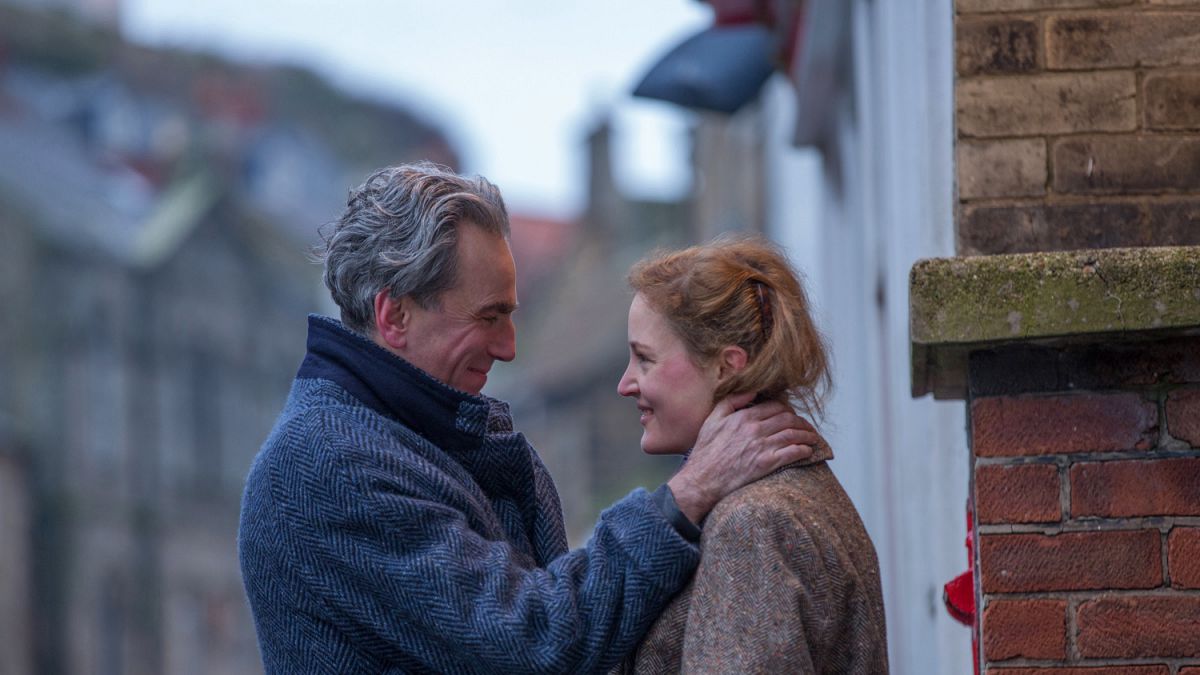Daniel Day-Lewis doesn’t look like a 60-year-old retiree. He’s wearing a striped T-shirt under a dark blue shirt, light brown trousers which descend no further than mid-calf and boots laced high above the ankle he could easily have worn as a young actor in My Beautiful Laundrette. Ditto the earring. He remains as thin and sleek as a whippet. Only the silvery stubble of his hair betrays the march of time.
Phantom Thread, he has announced, is to be his last film. After a screening at the Victoria and Albert Museum, he answered questions alongside director Paul Thomas Anderson and co-star Vicky Krieps. The film tells of Reynolds Woodcock, a designer of bespoke haute couture for wealthy society ladies whose business is briskly run by his spinster sister Cyril (Lesley Manville). His young lovers come and go but on a trip to their country retreat he meets a waitress called Alma (Krieps) who, unlike her predecessors, proves more determined to insinuate her way permanently into his heart.
When Anderson approached Day-Lewis about another collaboration after There Will Be Blood, the idea of a couturier working in London in the 1950s was not yet on the drawing board. “There wasn’t anything,” says Day-Lewis. “[Reynolds] didn’t exist at the beginning. It was just an idea that Paul had. I can’t remember what the idea was. We made one of those very rash decision that make in a kind of euphoria moment of discovery and then have to live with the consequences of that afterwards. We realised very very quickly what’s we’d let ourselves in for.”
“I was the cheerleader to say, we’re doing something,” explains Anderson. “I don’t know what it is.” The story that developed was steeped in the world of London couturiers, but Anderson also had a narrative forebear in mind for the story of an emotional bully and his much younger lover. “Anybody who’s been in a relationship for a long time will know the balance can change. I had Rebecca in my mind. My feeling about Rebecca is I just wish once Joan Fontaine would turn to Laurence Oliver and say, ‘Enough, I can’t take it any more.’” The location was also of intense appeal to Day-Lewis, who lives in New York and Country Wicklow. “I don’t know how we got into the idea of England but I certainly was happy because I grew up in that period. I grew up in London in the late Fifties and I remember that time really well. I remember the atmosphere of London which was so intoxicating for kids at that time because it was still being rebuilt so we played on bombsites. You could walk under the river to the Isle of Dogs through a tunnel. I grew up on the river. And we used to play on the bombsites. Rations had only finished two or three years before I was born so there was a sense that London was still growing back into itself. I thought that was exciting. Having thought about London we then both discovered there was a real world of couture still alive in London at that time.”
The location was also of intense appeal to Day-Lewis, who lives in New York and Country Wicklow. “I don’t know how we got into the idea of England but I certainly was happy because I grew up in that period. I grew up in London in the late Fifties and I remember that time really well. I remember the atmosphere of London which was so intoxicating for kids at that time because it was still being rebuilt so we played on bombsites. You could walk under the river to the Isle of Dogs through a tunnel. I grew up on the river. And we used to play on the bombsites. Rations had only finished two or three years before I was born so there was a sense that London was still growing back into itself. I thought that was exciting. Having thought about London we then both discovered there was a real world of couture still alive in London at that time.”
The script, once in place, was sent out to actresses, among them the Luxembourg-born, Berlin-based Krieps, 34. Remarkably, she videotaped her first audition without having read the names attached to the project on the email. “I find it important to take a decision according to the work. I always try to not read the name in order not to be misled judging something because someone’s famous. I just taped the thing. When my agent called me to say that they were very happy with the tape, she asked me if I knew who it was and I said, “No, I didn’t read the name. It’s a student film in England?”
Perhaps in her co-star’s eyes it almost was a student film. He argues that no world can be created without going back to the beginning to invent a new world. “The experience is often dictated by the nature of the story that you’re telling, the environment in which you’re telling it, but mainly in the interaction with these very particular characters. We all had to go back to infancy to start again. So that’s where you start. It felt like we were just trying to grab our first few breaths in a completely new world. Each world has its own very particular mysteries that you’re striving to discover. The thing I like most about Paul is the thing I ought to like least. There’s nothing mad you can do that he won’t encourage you to be madder. You’re always so close to the line of chaos - you have to be for it to be alive. This misunderstanding about preparation – yeah, you prepare for a long period of time if you’re lucky enough to be able to do that. It’s a privilege. But the only reason you prepare is so that you cannot have a clue what you’re doing when you start. And have the confidence not to have a clue what’s going to happen. It’s to give you that freedom to be that close to chaos all the time.”
The film has half a dozen Oscar nominations – for best picture, Anderson, Day-Lewis, Manville, Mark Bridges’ costumes and Jonny Greenwood’s insinuating score. Krieps’ hugely beguiling performance has been unfairly overlooked. “I definitely needed time to understand Alma and why she does what she did,” she says. “And I think I never understood. I think I don’t understand now, and I just trusted my intuition and I trusted Paul that the story will live through us and maybe be stronger than what we know. I think she’s just very free. If I would have tried to understand her with names and adjectives I would have failed. I tried to not give her adjectives and let her be free.”
If she was nervous, according to Anderson it didn’t show. “Daniel came to me about 10 days in and said, ‘She makes me nervous.’” We’ll be seeing a lot more of Krieps. We won’t apparently be seeing any more of Day-Lewis. Into his retirement he takes another skill to add to boxing, surviving in the wild, oil-drilling, laundry services and of course cobbling. To play a designer he put himself through an intense apprenticeship in dressmaking at the feet of Marc Happel, director New York City Ballet’s costume workshop, and even worked up a copy of a classic design.
“You have to choose what you can learn knowing that you can’t learn it all. I thought hand-sewing is very important for couture, but I wanted to learn how to drape if I possibly could. Marc is a master draper so that’s how I came to be with him. It was fascinating to work on a form in three dimensions. I foolishly chose a Balenciaga dress that looked so simple that I thought, maybe I can get away with that one. And the construction turned out to be quite complicated.”
It has stood him in good stead domestically. “I have to do all the sewing in the house because no one else will. I’m good at mending things. I got quite good at buttonholes. I was told that you have to sew 100 buttonholes to make a decent one.”













Add comment